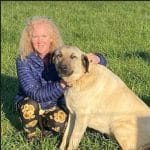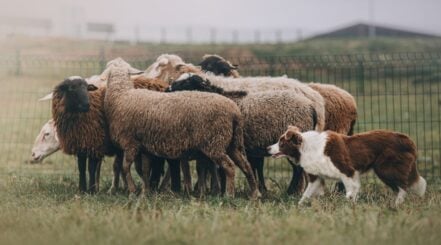The Beauceron is a French shepherding breed whose name comes from an agricultural region southwest of Paris. Also known as the Berger de Beauce or the Bas Rouge, the Beauceron is one of two categories of French shepherds identified in the nineteenth century.
This versatile breed excels at more than just herding sheep. Beaucerons have a long history of military and police work and were instrumental in the trench warfare of World War I. A picture of a French Beauceron leaping over a trench to help German forces penetrate the British line is displayed in the British War Museum.
The Beauceron is not well known outside France, and the breed has remained relatively pure. No outside breeds have been added to the genetic pool within that country. Although initially a working farm shepherd, today’s Beauceron fulfills a role similar to the German Shepherd and is used in military and police work, assistance work, and many canine sports.
Breed History

A passage in a 1587 manuscript mentions a dog matching the Beauceron’s description. A multi-purpose dog, the Beauceron was used initially not only to move and protect herds of sheep but also to protect home and family. By the Universal Exposition in Paris of 1863, an exhibitor showed a black dog with rust markings, upright ears, and wolflike build with only a few differences from the modern Beauceron.
The Society Central Canine, founded in 1882, registered the first “Berger de Beauce” in September 1893. Enthusiasts identified two groups of French shepherds in the late 1800s: the long-haired Shepherd of the Brie (Briard) and the shorter-haired Shepherd of Beauce (Beauceron). By 1922, the breed standard was set, and the Club des Amis Du Beauceron, or “Friends of the Beauceron,” was created.
Temperament

Although highly trainable, Beaucerons are not for the inexperienced dog owner. Unlike shepherds who nip at heels or dart near the sheep to move them, the Beauceron moves them calmly and quietly from a distance. Called “the country gentleman” by the French writer Colette and described as having an unusual “depth” not found in other dogs, Beaucerons are generally good with children and deeply attached to their people.
Size & Appearance

Modern Beaucerons have changed significantly since their early days. The breed has added substance through the years. The current breed standard states that males must be between 25 1/2 and 27 1/2 inches at the shoulder. Females are slightly smaller at 24 to 26 1/2 inches tall. His ears may either be cropped and carried upright or natural and carried half pricked or drop-eared, standing away from his cheeks.
The Beauceron’s forequarters are particularly important as they relate to his soundness. Structural unsoundness would compromise the Beauceron’s ability to work and fatigue resistance. His long, sloping shoulder gives his stride freedom and reach, and his powerful hindquarters propel him with minimal wasted effort. The Beauceron’s double dewclaws are close to the foot. Form creates functionality, and his conformation allows him to move as fluidly and effortlessly as a sheepdog must to cover long distances and turn on a dime as needed.
Coat & Colors

The modern Beauceron’s coat must be black and tan or a mixture of gray, black, or tan spots on a white background, called harlequin. Some white hairs on the chest are acceptable in the black and tan variety. The harlequin is black and tan as the base color, with patches of bluish-gray distributed over the body, and may have a predominantly black coat.
The Beauceron’s dense outer coat is coarse and of medium length, approximately 1 1/4 to 1 1/2 inches long, lying close to the body. His hair is longer around the neck, and his legs and tail are fringed. The breed’s softer gray undercoat is dense and downy but doesn’t show through his outer coat. Beaucerons don’t require trips to the groomer, but they are heavy daily shedders and blow their undercoat twice yearly.
Living Conditions

Because of his size and activity level, Beaucerons thrive in a working setting. A job like this engages all the dog’s needs. He’ll be mentally stimulated, and running on the farm will fulfill his need for exercise. Because most potential Beauceron owners don’t have working sheep or cattle farms, focus on activities for your Beauceron that provide him an outlet for his energy and work ethic. Flyball, agility, and even Schutzhund and training for pulling a cart are great options for Beaucerons.
Training

Because they’re so clever and know their job, they may be surprisingly independent and unwilling to follow an owner they see as timid or reticent. Because Beauceons tend to have dominant personalities, a prudent owner should teach basic obedience commands early and reinforce them frequently.
Socialize Beaucerons as pups to situations similar to those they may encounter in adulthood. They don’t naturally accept strangers and tend to remain aloof. If you need your Beauceron to be trustworthy around more than just his immediate family, spend his first year exposing him to as many different situations as possible. Expose him to new people and places and unusual sights and sounds.
Health

Hip Dysplasia
Like many larger working breeds, the Beauceron may suffer from joint dysplasia, a painful condition that limits mobility. Breeding dogs should have an Orthopedic Foundation for Animals (OFA) or PennHIP Evaluation, and buyers should choose puppies from parents with good evaluation scores. Your veterinarian can recommend a feeding program for your pup designed to promote slow, steady growth, which may help limit the development of growth-related joint dysplasia.
Osteochondrosis Dissecans
Osteochondrosis Dissecans (OCD) is a developmental issue resulting from a disturbance in bone formation. OCD often occurs in a dog’s shoulders. In dogs that grow rapidly, the growth may be faster than the blood supply can support. In this case, cartilage can develop abnormally and cause pain, lameness, and degenerative arthritis. Some instances may advance so that flaps of diseased cartilage separate from the remaining cartilage surface.
Most dogs with OCD show signs before they are a year old. Common symptoms are pain and subsequent lameness, stiffness, swelling, unwillingness to play, or general depression. See your vet for an evaluation if your dog displays joint pain symptoms. Radiographs, CT scans, or MRIs may be necessary to diagnose the issue properly.
Dilated Cardiomyopathy
In Dilated Cardiomyopathy (DCM), the heart has a decreased ability to pump blood through the vascular system. The heart chamber walls are thinner than usual, resulting in a weaker heart that cannot pump as well as it should. Symptoms of DCM include coughing, reduced appetite, fatigue, and a swollen abdomen. Although DCM is incurable, your veterinarian can help you can manage it with medication.
Progressive Retinal Atrophy
If your dog appears to be losing sight and there are no visible cataracts, he may have Progressive Retinal Atrophy (PRA). One of the most frightening aspects of PRA is that by the time symptoms are evident, significant loss of sight has already occurred. The only visible change may be that his retinas may seem shinier than usual.
If your Beauceron has PRA, he may become increasingly unwilling to go into a darker area or bump into things in a new environment. If you notice your dog acting like he struggles to see, make an appointment to have him screened. Unfortunately, there is currently no cure for PRA, but you can modify your home and routine to make getting around easier for him to manage.
Gastric Torsion
Feeding only a single meal daily increases the risk of gastric torsion, commonly known as bloat. Bloat is a life-threatening emergency condition. It can occur in any breed but is typically seen in deep-chested dogs like the Beauceron. To reduce the risk of gastric torsion, split your dog’s ration into two or more daily feedings.
To guard against bloat, restrict your dog’s exercise immediately after eating a large meal or drinking lots of water. Feed a calcium-rich kibble with protein sources such as meat/lamb meal, fish meal, chicken by-product meal, meat meal, or bone meal near the top of the list of ingredients. These precautions may help him avoid this potentially fatal condition.
Allergies
Because Beacerons are particularly prone to food allergies, take special care with your dog’s diet. If your dog has recurrent ear infections, facial itching, feet licking and chewing, and belly itching, suspect an allergy to a component in his food. The most common allergens in dog food are proteins from dairy, beef, chicken, chicken eggs, soy, or wheat gluten. Most regular pet foods contain at least one of these ingredients, so you’ll need to eliminate the allergen from your dog’s diet so he can heal.
Nutrition
Aim for slow, steady growth when you develop a feeding regimen for your Beauceron pup. Growing pups eat more than mature dogs, but Beaucerons burn lots of energy. Follow the feeding chart on the feed brand, but be sure to choose a puppy food that meets the Association of American Feed Control Officials (AAFCO) standards. Feeding for moderate growth rates may help mitigate the risk of musculoskeletal problems like joint dysplasia related to rapid growth.
Your Beauceron may eat two to three cups per day as an adult, broken into two meals, depending on his activity level. Monitor his weight and adjust his meals accordingly. Feed the best quality nutrition that you can afford to keep this active breed healthy. A high-quality kibble including meat protein, fiber, healthy carbs, omega-3 fatty acids, vitamins, and minerals will meet his nutritional needs. You’ll be less likely to have to add costly supplements.
Grooming

Beaucerons have a short, hard outer coat over their thicker seasonal undercoat. This breed blows its undercoat between seasons, and an undercoat rake can help remove loose hairs to manage his heaviest shedding. He will shed more than many other breeds throughout the season. To minimize daily shedding, run a pin brush through his coat daily.
Beaucerons’ grooming needs are relatively simple beyond his shedding. As weather allows, you may bathe your Beauceron once every four to six weeks with a shampoo and conditioner made specifically for dogs. As with any dog, trim their nails as needed and brush your dog’s teeth regularly with veterinary toothpaste.
Breeders & Puppy Costs
Beaucerons are relatively rare in the United States, and their price reflects their rarity. A pup may cost between $1,200 and $2,000.
Rescues & Shelters

Because Beaucerons are rare in the United States, you may not find one in a local shelter. The American Beauceron Club has a rescue page, as does RescueMe.org.
As Family Pets
In general, this breed is:
- A friendly, hardworking dog.
- Loyal and protective of his family.
- Calm but with great stamina.
- Healthiest with about an hour total of daily exercise.
- Independent but biddable.
- Best in a home with a large yard unless you can otherwise meet his exercise needs.
Final Thoughts
There’s a reason the French author Colette wrote glowingly of the Beauceron. This sensitive and noble breed can be the perfect companion in the right setting. Understand his reserved and discriminating temperament and socialize him thoroughly when he’s a pup. Socialization during his first year will help him become a calm, confident companion who will give his life to you. Be sure you are prepared to help provide him the secure home this rare but fascinating breed deserves.





